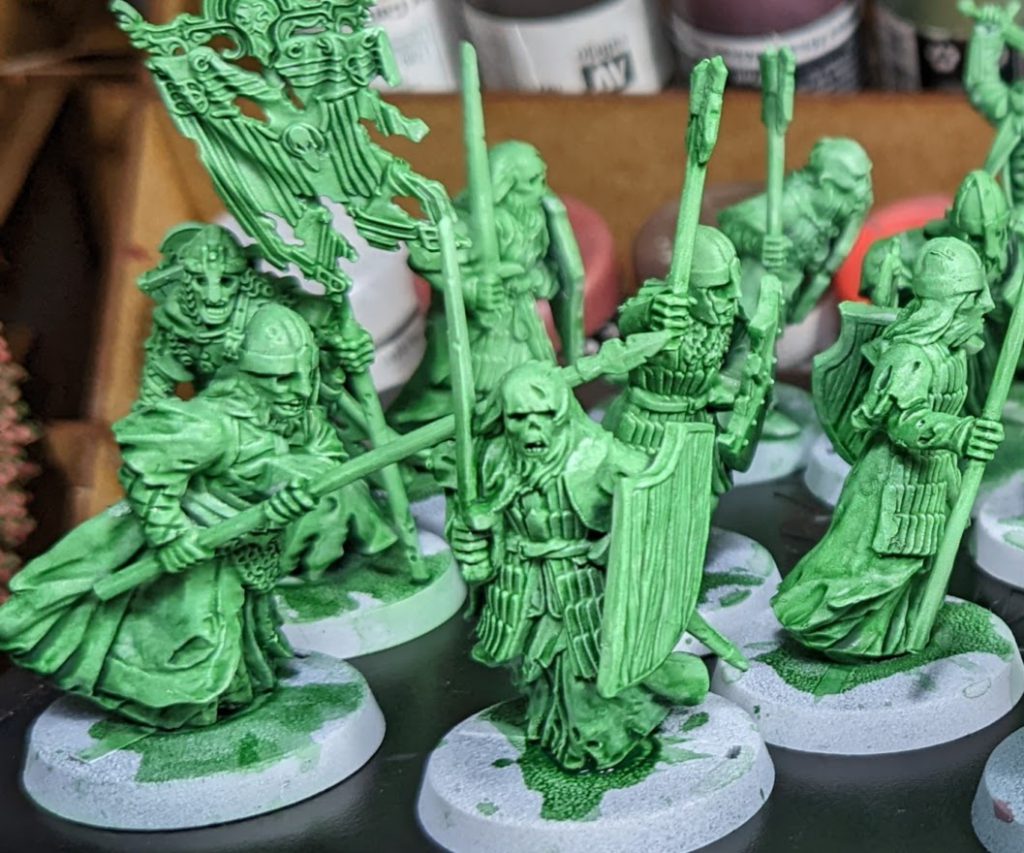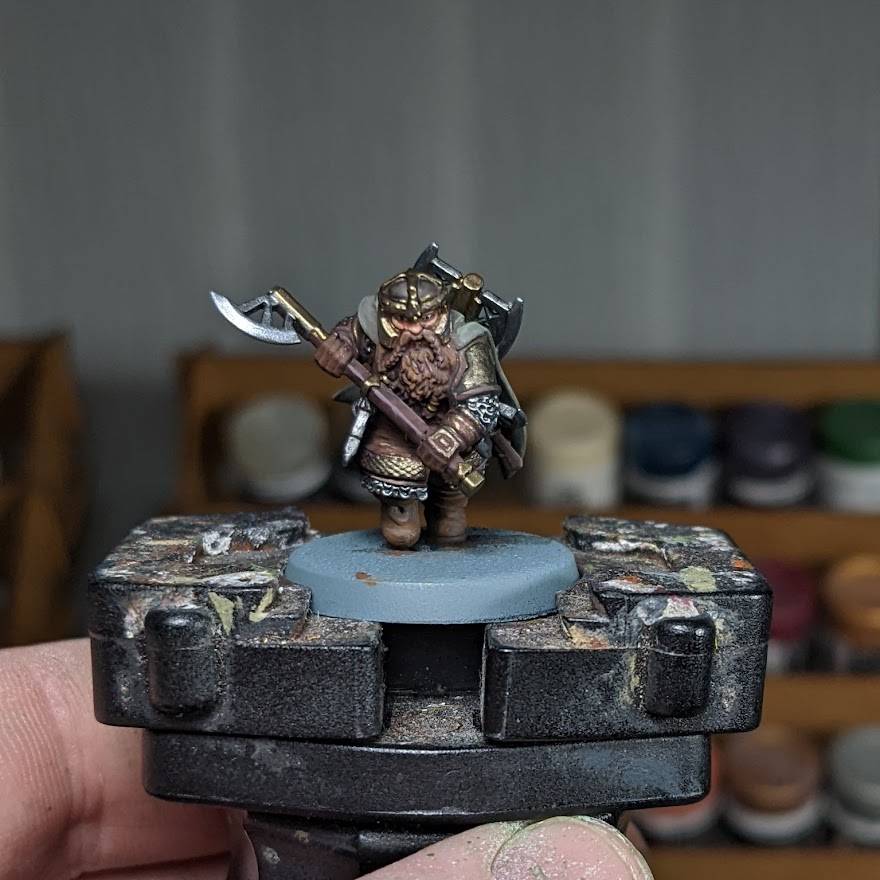In New Year New Armies, Lupe attempts to go from a Warhammer Zero with no playable forces for any mainline Games Workshop game, to a Warhammer Hero with an army for each of Warhammer 40,000, Age of Sigmar, and Middle Earth Strategy Battle Game and some games under his belt to (re)learn the rules.
Next up on the chopping block for this endeavour is Middle Earth Strategy Battle Game, the Luke of the Hemsworth trio of Games Workshop mainline games. It’s probably actually the best game that Games Workshop makes, and I’m more excited about jumping into this one than either of the other, better-known Hemsworths. I should probably rephrase that.
Thanks to my sibling I was ready to assemble my forces and herald the Return of the King.

The Return of the Supplement Book
So my first issue was, clutching my copy of Armies of the Lord of the Rings, that I couldn’t work out how on earth I was supposed to actually run the three hunters with the ghosts. I knew it was possible because I’d seen multiple people do it, but for the life of me I couldn’t work out how. It took a while for me to realise that I actually needed a completely different book, Gondor at War which included some Legendary Legions (special variations on core factions), one of which is The Return of the King.
This is the force to represent the moment in the movie where Aragorn, Legolas and Gimli charge off the ships flanked by the army of the dead, and into the forces at Pelennor Fields. My Tolkein nerdery forces me to point out that this is something that only happens in the movie, because in the books the dead have been released from their oath by this stage (that happens after they take the ships to begin with). Aragorn actually arrives at Pelennor with the Grey Company (a group of the Rangers of the North), Elronds’ sons, and a load of soldiers from the provinces that had been blocked from arriving to give aid by the corsairs in the estuary. I would try and resist mentioning this were it not for the fact that The Grey Company is another Legendary Legion in this book and I absolutely am going to have to get some ranger minis at some stage and make a little army of them.
But back to The Return of the King. The legion itself must have Aragorn as its leader, and it must include the King of the Dead. Other than that, I’m free to add in Legolas and Gimli, and then ghosts as I wish. As I mentioned in my getting started article, I was surprised to discover that a couple of dozen ghosts, the three living heroes, and the ghost king and his buddies is not just a full army but substantially more than a full army. Putting together a list of how many ghosts I was generously gifted I discovered I had more than 1000pts all told, which since large battles are 700-800pts is probably excessive. In the end I realised I had enough to paint up the models so I could do Return of the King or just the standard Army of the Dead faction, which is cool. At some point I might want to pick up some ghostly riders, but for now this will serve me well.
The Army of the Dead
The goal here was to hammer these spooks out as fast as possible. I resisted the urge to get fancy and instead just went for the simplest possible scheme I could imagine:
- Prime white
- Wash all over with Biel Tan Green shade paint thinned 1:1 with water
- Once dry apply a second coat
- Once dry carefully apply it neat over the models avoiding pooling on flat surfaces
- Very very light drybrush with pure white
Bish bash bosh. Not much more to say really.

The Three Hunters
Now these three were rather more intensive to paint, and I gave them a lot more time and effort. Rather than go over how I did each one in detail, I want to instead talk about how I approached painting these three, and why I made the choices I did, as I think that’s something we don’t necessarily always cover in detail.
I knew that I wanted to cleave closely to the movie looks, so the first thing I did was trawl the internet trying to find the best images I could of their outfits and appearances. I managed to find a combination of images depicting the actual costumes themselves from behind the scenes footage, stills from the movies themselves, and also officially licensed representations that are presented in more detail than the GW models. Broadly you want to look at the highest-quality representation of your subject matter, even if you cannot represent all that quality on the miniature, because the overall look of that piece will influence how you paint the simplified version.
With Aragorn the thing that jumped out at me most comparing the studio paint job and the movie still and costume photographs was how much browner the studio version was than the real thing. Ignoring the elven cloak, Aragorn’s clothing in the movies is all green-grey shades of near-black. Now, this isn’t ideal on a miniature – first of all having all of his clothes this similar shade would make it hard to pick out the different layers, and secondly this kind of green-grey leather colour tends to make minis look a bit washed out. But I knew immediately I would want to be making his clothes much closer to black, and introducing some cooler tones. I mixed up a variety of near blacks (Vallejo German Grey, Vallejo Black Grey and a mix of Vallejo Panzer Aces Dark Rust and Black were the key paints used) to make this effect come through.
I was also baffled at the decision to leave out the splash of red from Aragorn’s undershirt, but as I painted the model I began to realise why they’d done it – with such a drab miniature, a bright contrast point there would draw attention away from the face. I decided to keep the red but dull it down considerably, settling on something close to Scale 75 Deep Red.
In terms of other features, the studio painter decided again to go much browner than I would have – Aragorn’s hair in the movies is near-black, and so is his short beard, and that’s the direction I went in. Other than that I was happy to take some cues from the GW team: a white-silver on the evenstar necklace (Scale 75 White Alchemy), the grey-green on the elven cloak (Scale 75 Field Grey). I didn’t add the splash of green on the leaf buckle, as I found that again would draw the eye down rather than to the face, but instead changed the tone of the gold I used to a much softer, greenish gold (Scale 75 Necro Gold), which I would use throughout the three models to tie better into the overall scheme.

Now I had Aragorn as my baseline to work from, I began to work on Gimli and Legolas to match. The greenish-gold gave me a nice starting point for the gold details for Gimli, and that tone influenced my choice of other colours for him. He needed a warmer look, so I incorporated Scale 75 Red Leather as one of the main colours on him, and a chestnut brown for his beard (mixed myself rather than from a pot). Of course his cloak matches Aragorn’s, and that just left the steel areas.
I had chosen with Aragorn to go with an incredibly clean sharp steel for Anduril, as I wanted to make the legendary blade jump out. For Gimli though, there was just too much steel to paint so brightly – it would have distracted from the rest of the miniature. As such I chose some browner, slightly duller tones for then, keeping the very bright sheen only at the blade edge on the axes. Scale 75 Thrash Metal was my choice here, a nice steel colour with some brown tones worked in already.

Legolas was definitely the one that gave me most pause here, especially because I simply think the sculpt is the least good of the three. I decided to use the elven cloak as the central point to build the colour palette around, as that seemed a good thematic place to begin. Looking at reference photos I found that his jerkin is close to the same colour, and so I slightly brightened it and used the same colour on both. Other than that I stuck to nice, neutral, natural colours, to reflect the woodland roots of the model – Panzer Aces Old Wood was a godsend here, as it often is in my opinion.
His skin I painted considerably lighter than Aragorn’s, using the same palette but starting with Aragorn’s highlight shade and then working up from there. For Gimli’s skin I did something similar but in reverse, using the shade colours for Aragorn and then building the tone around that. The reason for doing this is that by keeping a common point for all three models, but then expanding their individual skin tone around it, the models look much more like they match despite having darker or lighter tones. What colour someone’s skin looks like has as much to do with the lighting they’re under as their skin itself, and so this helps them feel like a cohesive set. When you’re doing a group of models with varying skin tones, try and use paints from across a consistent set of colours so there’s this same shared tonal palette, even if the skin tones themselves are all very different.

An Unexpectedly Short Journey

And that was pretty much it. I based the minis in my usual go-to way (some Vallejo texture paste, a brown paint over, then some static grass and flower tufts) and I was done. It was curiously deflating to be done so fast in truth, and I found myself itching to do more Middle Earth models because of it. As such I grabbed some spare Morannon Orcs from my sibling and got to painting them as well. I’ll put together an article in this series about how I expanded this army out to an evil force as well.
Next time though I’ll be heading off to the Mortal Realms to get to grips with some extremely sticky characters…
Have any questions or feedback? Drop us a note in the comments below or email us at contact@goonhammer.com.


